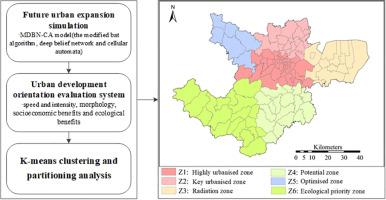Science of the Total Environment ( IF 8.2 ) Pub Date : 2021-10-06 , DOI: 10.1016/j.scitotenv.2021.150813 Ye Zhou 1 , Tao Wu 2 , Yechenzi Wang 3

|
Sustainable urban development is the key to regional urban development policy-making. Therefore, the comprehensive spatial zoning of rapidly urbanising areas is important. In this study, a novel spatial zoning framework was established based on the future urban spatiotemporal pattern and multidimensional dynamic index system at the township scale. First, the urban expansion of Hangzhou in 2025 was simulated based on a new method in which the hybrid bat algorithm and deep belief network (DBN) are coupled with the cellular automata (CA) model (MDBN-CA). Second, an urban development-oriented evaluation system was established at the township scale based on urban expansion simulations and indicators, including the speed and intensity, morphology, socioeconomic and ecological benefits. Finally, Hangzhou was zoned by using the K-means method. The results show that: (1) The MDBN-CA model effectively overcomes the limitations of traditional neural networks, yielding an increase in the simulation accuracy and spatial pattern similarity of 3.70% and 10.11%, respectively; (2) Hangzhou can be divided into six zones according to the 2025 urban expansion, that is, the highly urbanised, key urbanised, radiation, potential, optimised, and ecological priority zones; (3) Based on the current development trends, urban expansion in Hangzhou will have relatively large benefits by 2025. However, problems with respect to the unbalanced development of land urbanisation and population urbanisation, as well as the low efficiency of land use, were identified. Based on the results of this study, suggestions are provided with respect to spatial pattern reconstruction, urban function transformation, efficient land use, and green and healthy development; (4) Based on the combination of the MDBN-CA and K-means models with the zoning framework of the comprehensive benefits evaluation system of urban expansion, future urban expansion can be predicted and analysed.
中文翻译:

快速城市化地区的城市扩张模拟与开发导向区划:以杭州为例
可持续城市发展是区域城市发展决策的关键。因此,快速城市化地区的综合空间分区很重要。本研究基于未来城市时空格局和乡镇尺度多维动态指标体系,建立了新的空间分区框架。首先,基于混合蝙蝠算法和深度信念网络(DBN)与元胞自动机(CA)模型(MDBN-CA)耦合的新方法,模拟了杭州2025年的城市扩张。二是在乡镇尺度上建立以城市发展为导向的评价体系,基于城市扩张的速度和强度、形态、社会经济和生态效益等指标。最后,使用K-means方法对杭州进行了分区。结果表明:(1)MDBN-CA模型有效克服了传统神经网络的局限性,模拟精度和空间格局相似度分别提高了3.70%和10.11%;(2)杭州按照2025年城市扩张可划分为高度城市化、重点城市化、辐射、潜力、优化、生态优先区6个区;(3)从当前发展趋势来看,到2025年杭州城市扩张将产生较大效益,但也存在土地城镇化与人口城镇化发展不平衡、土地利用效率低等问题. 根据研究结果,提出空间格局重构、城市功能改造、土地高效利用,绿色健康发展;(4)基于MDBN-CA和K-means模型与城市扩张综合效益评价体系的分区框架相结合,可以预测和分析未来的城市扩张。











































 京公网安备 11010802027423号
京公网安备 11010802027423号